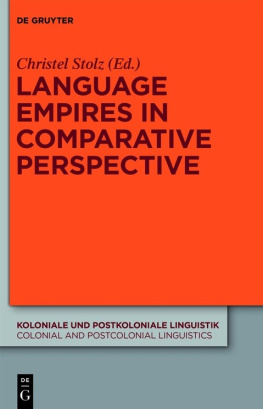Also Available From Bloomsbury
Bloomsbury Companion to Discourse Analysis, edited
by Ken Hyland and Brian Paltridge
Bloomsbury Companion to Second Language
Acquisition, edited by Ernesto Macaro
First Language Acquisition in Spanish, Gilda Socarras
Language Acquisition and Language Socialization, edited by Claire Kramsch
Parameter Setting in Language Acquisition, Dalila Ayoun
Second Language Identities, David Block
Young Language Learners Motivation and Attitudes
Longitudinal, Comparative and Explanatory Perspectives
Sybille Heinzmann

Bloomsbury Academic
An imprint of Bloomsbury Publishing Plc
50 Bedford Square | 1385 Broadway |
London | New York |
WC1B 3DP | NY 10018 |
UK | USA |
www.bloomsbury.com
First published 2013
Sybille Heinzmann, 2013
All rights reserved. No part of this publication may be reproduced or transmitted in any form or by any means, electronic or mechanical, including photocopying, recording, or any information storage or retrieval system, without prior permission in writing from the publishers.
Sybille Heinzmann has asserted her right under the Copyright, Designs and Patents Act, 1988, to be identified as author of this work.
No responsibility for loss caused to any individual or organization acting on or refraining from action as a result of the material in this publication can be accepted by Bloomsbury Academic or the author.
British Library Cataloguing in Publication Data
A catalogue record for this book is available from the British Library.
ISBN: 978-1-4411-5783-6
Library of Congress Cataloging-in-Publication Data
Heinzmann, Sybille.
Young Language Learners motivation and attitudes : longitudinal, comparative and explanatory perspectives / Sybille Heinzmann.
pages cm
Includes bibliographical references and index.
ISBN 978-1-4411-9427-5 (hardcover) -- ISBN 978-1-4411-6736-1 (pdf) -- ISBN 978-1-4411-5783-6 (epub) 1. Language and languages--Study and teaching (Elementary) 2. Language arts (Elementary) I. Title.
P51.H45 2013
372.6--dc23
2013007979
Typeset by Fakenham Prepress Solutions, Fakenham, Norfolk NR21 8NN
To Daniel and Kainoa
This book and the empirical research preceding it could not have been completed without the help of a great many people, and I would like to express my gratitude to all those who have contributed in different ways to this endeavour.
First and foremost I would like to thank my husband Daniel Agten for both his patience and his impatience with me during the many years I invested into this project, his unfaltering belief in me, and his unwavering support. My parents Marcel Heinzmann and Judith Furrer I want to thank for always having let me go my own way, always having believed in me and at the same time never having asked anything more from me than simply giving it my best shot.
I am also deeply indebted to Prof. Dr Didier Maillat, Prof. Dr Richard Schmidt, Prof. Dr Andrea Haenni Hoti and Prof. Dr Peter Trudgill for their tireless academic and personal support. Furthermore, I would like to express my heartfelt gratitude to Prof. Dr Didier Maillat, Prof. Dr Richard Schmidt and Dr Martin Lamb for their valuable feedback on earlier versions of parts of this manuscript. I also want to acknowledge the Swiss National Science Foundation that supported this study with a scholarship that greatly contributed to its advancement and quality.
When starting out upon this study I was a complete novice in the field of statistics. I could never have accomplished the analysis of the data without the help of a great many people. I am thankful to Prof. Dr Eldad Davidov, Dr Odilo Huber, Prof. Dr Marianne Mller, Prof. Dr Werner Wicki, Dr Carmine Maiello and Andrea Hauser for having taken the time to answer my countless questions about statistics and for providing help where help was needed.
Furthermore, I could also count on the help of a number of people for the many data collections that this study entailed. In this respect my thanks go to Lenny Bugayong, Chantal Imhof and Luzia Wicki, who helped me with the data collections in the subsample.
Naturally, I also want to express my gratitude to my dear friends who never tired of listening to my worries and complaints in all those years. In particular, I want to thank Fabiola Eyholzer for having taken the time to format the manuscript and Michael Rollins for being such an unfailing proofreader.
I am also grateful to Prof. Dr Drnyei and Prof. Dr Gardner who granted me permission to reproduce their diagrams and to the Bloomsbury editorial team for their professional and efficient work.
| Schweizerische Konferenz der kantonalen Erziehungsdirektoren (Swiss Conference of Cantonal Educational Ministers) |
| English as a foreign language |
| English as a lingua franca |
| Foreign language |
| Mother tongue, first language |
| Second language, in the context of this study: first foreign language taught at school |
| Third language, in the context of this study: second foreign language taught at school |
| Latent growth curve |
| Maximum likelihood |
| Structural equation modelling |
| Second language acquisition |
| Target language |
| Willingness to communicate |
If you want to build a ship, dont herd people together to collect wood and dont assign them tasks and work, but rather teach them to long for the endless immensity of the sea.
Antoine de Saint-Exupry
This book details the findings of a longitudinal study investigating Swiss primary school childrens motivational and attitudinal dispositions with regard to English and French which are the two foreign languages (henceforth s) taught at the primary school level in most parts of German-speaking Switzerland.
The book approaches the motivation and attitudes of young learners from three rather distinct perspectives. The first perspective is a longitudinal perspective and is devoted to a macro-level analysis of primary school childrens motivational and attitudinal trajectory with respect to English across a time span of two years. The comparative perspective delves into a comparison of learners motivational and attitudinal profiles with respect to English and French. The explanatory perspective, finally, identifies key antecedents of the learners motivational and attitudinal dispositions, thereby opening up possible paths for intervention.
The study was undertaken in the context of a major school reform in Switzerland involving the introduction of a second when they are 1112 years old.
The implementation of this reform is in line with the language policy of the European Union, whose professed aim it is to make future European citizens functionally multilingual in order to secure mobility and cohesion in instruction at the pre-school or primary school level and mirrors similar educational reforms implemented in many Asian and other European countries (see Cenoz, 2004, pp. 2023; Enever, 2011, pp. 10, 24).
Despite the increased attention that instruction at the primary school level to build up favourable motivational and attitudinal dispositions that will be conducive to lifelong learning (see Bildungsplanung Zentralschweiz, 2004). It is exactly these affective dimensions of language learning that are the focus of this book.
Next page









